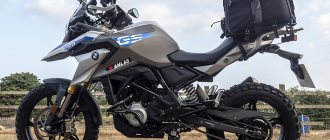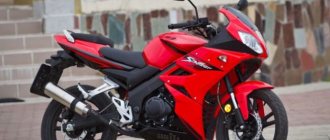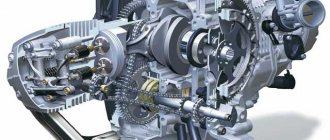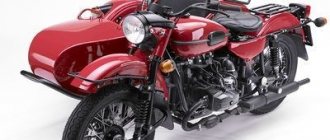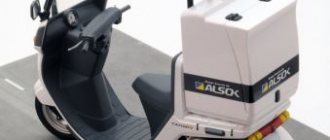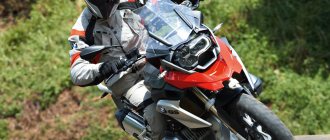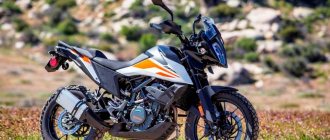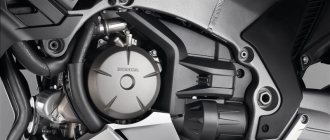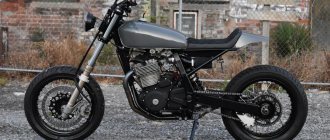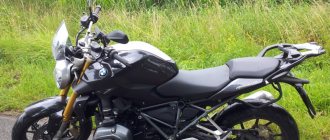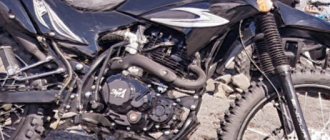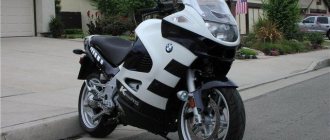Model class : touring enduro
Years of production/sales: 2004-
BMW R1200GS model appeared in March 2004 and became the successor to the BMW R1150GS model. The main changes affected the appearance and technical part:
- New engine : 1170cc, with balancer shaft, 100 (98 for the German market) hp. power and 115 Nm of torque.
- New injection system : BMS-K.
- New design : the design of the plastic, gas tank, and dashboard is changing.
- New ABS system : Since 2006, ABS II with electric booster has been replaced by the more reliable ABS III.
- Reduced curb weight : from 249 to 225 kg.
- New options : electronically adjustable suspension (ESA), stability control (ASC), traction control system - since 2008; LED headlights, keyless entry, quickshifter, security system - from 2014-2016.
In all other respects, the BMW R1200GS model has the classic features of BMW R-series motorcycles: a 2-cylinder boxer engine, proprietary Telelever and Paralever suspensions, cardan drive and ABS. In addition, the BMW R1200GS model has many touring options - heated grips, hand protection, standard saddlebag mounts, cruise control, etc.
Main modifications of the BMW R1200GS:
- BMW R1200GS – regular version. The standard version was sold with alloy wheels (spoke wheels are available as an option).
- BMW R1200GS Adventure – top version. Available since 2005. It features spoked wheels in the base, longer travel suspensions, a 33-liter fuel tank, as well as a windshield, protective linings on the cylinders, arches and plastic aerodynamic elements.
Main generations of BMW R1200GS:
- BMW R1200GS (2004-2007) – first generation. Models of these years produce from 98 (for the German market) to 100 hp. power and 115 Nm of torque.
- BMW R1200GS (2008-2009) – second generation. The compression ratio increases to 12.0:1, maximum power increases to 105 hp, versions with ABS II lose the electric brake booster. New options appear: ESA (electronic suspension adjustment) and ASC (traction control). The model is undergoing a slight restyling, changing the shape of the plastic on the tank, the design of the rims and some other visual elements.
- BMW R1200GS (2010-2012) – third generation. The engine receives a new cylinder head with two camshafts (DOHC), which increases the maximum speed to 8500 rpm and the maximum power to 110 hp. at 7750 rpm.
- BMW R1200GS (2013-) – fourth generation. The model receives a new liquid-cooled engine with 125 hp. power and 125 Nm of torque; updated appearance (small cosmetic differences, cantilever swingarm with cardan on the left side); new brakes with a larger diameter rear disc and radial mounted front calipers; increased tire size; new clutch (multi-disc slipper in an oil bath); curb weight increased by 9 kg; electronic throttle with 5 traction control modes; new generation Paralever rear suspension – EVO (swingarm length and ground clearance increased); non-adjustable hydraulic steering damper in stock. New electronic options - quick shifter, LED headlights, Keyless Ride, Dynamic ESA semi-active suspension, tire pressure monitoring system.
The current BMW R1200GS is BMW's flagship touring enduro, gaining popularity around the world. The model was repeatedly recognized as the motorcycle of the year and was the best-selling model in Europe and various countries.
In 2012, Cycle World magazine named the BMW R1200GS the "Most Successful Motorcycle of the Last 25 Years."
Brief history of the model
- 2004 – start of production and sales of the BMW R1200GS.
- late 2005 – early 2006 – start of production and sales of the BMW R1200GS Adventure.
- 2006 – appearance of modifications of the BMW R1200GS with ABS III.
- 2008 – second generation. On the regular version, the design of the plastic on the tank and the rims (in versions with cast aluminum wheels) change. On versions with ABS II, the electric brake booster is removed. Maximum engine power increases to 105 hp. by increasing the engine compression ratio (from 11.0 to 12.0). New electronic options appear - ESA, ASC.
- 2010 – third generation. The main difference was the use of new cylinder head with two camshafts (DOHC). Maximum power increases to 110 hp.
- 2013 – fourth generation. The BMW R1200GS gets a new liquid-fuel engine, styling changes, new brakes, clutch and a host of new electronic options. The turn signals now have one switch on the left remote control (instead of the traditional BMW two, on the corresponding remote controls). The Adventure version has a 30-liter aluminum fuel tank.
- 2014-2016 – additional options: LED headlights, keyless entry system, quick shifter. The ABS system receives new firmware, increasing the safety and adequacy of the system's response when cornering.
- 2017 – this year’s models received adaptive headlights and a damper on the gearbox output shaft (as on the Adventure version). The gearbox units have also been modified and improved. Standard GS models now have the same roll bars as the Adventure version.
So, continuing to choose a tourenduro for long trips with two people and with a load on roads and destinations, I could not pass by the big water goose. “This is a benchmark, you just have to.” “Screw him, he’s unreliable and glitchy.” “Wow, this is the best thing on the market” - something like this, in short, you can combine the opinions that I heard about the goose. With BMW tests, everything is not as simple as with Harleys and Triumphs - they are brought for a weekend once a year, there are a lot of people who want them. I arrived in the morning and left upset - everything was already planned until the evening. However, in the evening I was lucky, they were able to give me an hour and a half of free swimming. Since I had only tested the Triumph Tiger Explorer before, I have nothing else to compare it with. So, please do not consider the text below as biased toward BMW or Triumph)) I’ll say right away that the motorcycles are very similar, and their differences, in general, are in the nuances, which are discussed below. If anyone is ready to give the KTM 1190 a test, I’ll be happy))) This is perhaps the only touring bike that I would like to test before purchasing. Naturally, according to the concept: broken - bought. I rode almost everywhere I wanted. “Almost” because there was no way to ride in the rain or at night. Accordingly, I cannot evaluate the water and dirt protection, as well as the headlights. In general, it’s not a big problem, because... The headlights of the goose are considered almost standard in the class, and you can estimate the water resistance with your own eyes. 1. So, I take the largest goose - adventure - with about a 30-liter (!) tank. First stop at a gas station, I add 600 rubles - they fly by with a whistle. And this despite the fact that there was still about a quarter of the tank left. Again, you don’t need to keep the gun near the tank, you just insert it and that’s it. First point in favor of the goose against Tiger. For long-distance driving, I have already noticed more than once that a tank of 22-23 liters is not enough. Especially when you go 160+ with a consumption of about ten.
2. Box. Everything seems to be fine, but a couple of times the neutral switched on instead of the second one, and from time to time you have to look for the neutral itself. The Triumph box is definitely much clearer (and in general it’s better than even the Honda box on the Gold), one-on-one. Oh, yes, I almost forgot - the beha has a quick shifter in the base. Why this is on a heavy tourenduro, I still don’t understand. Not a track sportsman, really.
3. The brakes are just awesome! Nothing but delight! At first they seemed a little harsh, but after literally 15 minutes I got used to it and started to get a buzz. ABS works in such a way that you can’t feel it (but it works!). How they were able to do this - I still don’t understand. The brake performance is fantastic. ABS activations, subjectively (and on my car, for example, I turned off the ABS, because without it I feel more accurate and safer), do not reduce the braking distance (!!). There is no chirping either on the leg or on the arm (!). In general, brembes plus powerful brains work wonders. Another nice thing is that on the rear brake foot there are two, how can I describe it, tips or something. In short, that piece of iron with teeth that you press on. So, one tip is for sitting riding, the second is for long standing riding, it slightly raises the foot. Very comfortably! A big plus in favor of BMW.
4. Engine. The power of the Gusevsky boxer is enough everywhere (I didn’t turn it more than 220, and there are more of them like that, for experimentation, my usual speeds are up to 160-180), but I would like more traction at the very, very bottom. Accustomed to the fatty meat “down below” on large-volume V-twins, I stalled more than once in the first half hour, probably under the disapproving thoughts of motorists “you’ve stuck out beyond the stop line if you don’t know how to drive.” A strong fly in the ointment is the protection of the arches. How I hit these pipes with both feet when I rolled the bike back. And, damn it, the very bones on the shin.
Well, the vibrations are too high when moving. Two-two with a slight edge of Triumph due to Goose's stupid arcs and vibrations.
5. The standard windshield is not enough; at speeds above 130 it blows quite strongly (and definitely stronger than on the Triumph with the standard windshield). Plus the goose - the angle of the windshield can be changed on the fly with a mechanical thumb (well done for not installing a servo!) - on the Triumph the angle can also be changed manually without using a tool, but only by stopping and dismounting. Two or three, the English are leading.
6. The goose feels like its center of gravity is higher. Perhaps it was due to the larger tank, but I didn’t get the “riding a bicycle” feeling. It took about 30 minutes to adapt to the motorcycle. Two or four in favor of Triumph.
7. Keyless. A very convenient thing. Keychain in your pocket. Turning on the ignition with a button. Shutting down is the same. No stupid keys for you (I put on a raincoat and remembered that the key is in my pants pocket. A familiar bummer, right?))), no hassles. Definitely a plus for Behe. Triumphists are penny-pinchers! A cheap thing, definitely a must for motorcycles of this price. Three four
8. I got Bekha with a can of Akropovich. Rare shit. I liked it for the first 15 minutes (oh, at least someday I’ll ride on a forward flow)), after 15 minutes I really started to hesitate. I don’t know how people travel long distances with “this.” I wouldn’t go even 200 km from the city. Clearly, it’s not a plus or a minus for anyone, I just once again noted the pointlessness and ruthlessness of some tuning.
9. The cigarette lighter is in the base, and also with a non-standard socket. Bemeve, Triumph, take the example of Harley - it’s the same as on cars, and no hassle.
10. The mirrors are also small, but, unlike the Triumph, they do not vibrate at any speed. Plus in favor of Goose Four-four
11. Beha is much colder than Explorer. On the Explorer the eggs are downright hot, but not here. And nothing is hot at all. Five-four, the Bavarians lead
12. Suspension. In general, I expected some kind of revelation from the electronic suspension. In fact, it didn't happen. Excellent suspension, it damps everything - but Tiger’s feels no worse, and is mechanical and, as a result, more reliable. In general, I don’t presume to judge. It's entirely possible that I don't have the skills to figure it out. And so, of course, pits, hummocks, gravel, ridges, cut asphalt for motorcycles cease to exist altogether. Driving at an angle from cut asphalt to new, even high-positioned, is simply not felt. Speed bumps suck in their stomachs until they disappear Awesome, really!
13. Remote controls. As for me, they are overloaded and not intuitive. With the same cruise, I spent about three minutes figuring out how to activate it at all. There is also a small note regarding setting the speed - the set speed figure is not displayed on the instrument panel. Bullshit, of course, but unpleasant. But at least the heated handles are controlled from the remote control (hello, KTM, how did it even occur to you to do this through the menu? It’s not even a sore throat)) After washing with a Karcher under high pressure, over time, the buttons begin to jam. Accordingly, at the car wash you need to keep an eye on the washers so that they don’t screw around. There is no automatic turn off of the turn signals. Little bastards! A small plus for Triumph, high five
14. The second number liked it better on Gus - the wind protection is better and the fit is lower (on the Tiger the second number sits decently higher than the first). True, it’s a little hot for the right leg from the muffler can. Overall, six-five, Bayern leads.
15. I won’t write anything about the reliability and unreliability of geese. Everyone studies the issue for themselves and draws their own conclusions. Some write that he is a child prodigy, others that it is contraindicated to travel far from services. At the same time, I can’t help but say that Europe has the most geese traveling around, and this is an indicator.
16. The glove compartment on the tank for a credit card/transponder surprised me - the gaps are such that a finger can easily fit through. When handing over the motorcycle, it turned out that a buckle from a sling had been pushed there, which caused it to become so distorted.
17. I didn’t like the traction control (in particular, the work of the anti-wheelie) - it works a little abruptly, it can frighten a beginner. True, I did not test all engine operating modes. It is possible that in the “rain” it will be different. Not a minus or a plus, just a matter of minimal habit.
To summarize, the goose is definitely a more technologically advanced motorcycle. For some this is a plus, for others it is a minus. Tank Adventure allows you to stop thinking about gas stations even in remote places. But the cost of Adventure, in my opinion, is too high (although it no longer gives the impression of being recharged; it’s unclear why the prices for HD CVOs are high). Oh yes, when reviewing the Triumph, I had a lot of pink snot. It turned out that it is not Triumph that is so good, but the whole class of touring bikes)) The two tested motorcycles are identical, give or take, and both are great.
Specifications
Technical characteristics of BMW R1200GS:
| Model | BMW R1200GS |
| Motorcycle type | touring enduro |
| Year of issue | 2004- |
| Frame | composite, two-section, engine - load-bearing element |
| engine's type | 2-cylinder 4-stroke boxer (Boxer) |
| Working volume | 1170 cc |
| Bore x Stroke | 101x73 mm |
| Compression ratio | 11.0:1 (since 2008 - 12.0; since 2013 - 12.5:1) |
| Cooling | air-oil (since 2013 - air-liquid) |
| Number of valves | 4 valves per cylinder, 1 camshaft per cylinder head (DOHC - since 2010) |
| Fuel supply system | injector BMS-K+ |
| Ignition type | electronic |
| Maximum power | 100 hp at 7000 rpm (105 hp - 2008-2009; 110 hp - 2010-2012; 125 hp - since 2013) |
| Maximum torque | 115 Nm at 5500 rpm (120 Nm - 2010-2012; 125 Nm - since 2013) |
| Transmission | 6-speed |
| type of drive | cardan |
| Front tire size | 110/80 ZR19 (from 2013 - 120/70 R 19) |
| Rear tire size | 150/70 R17 (2013 - 170/60 R 17) |
| Front brakes | 2 discs, 305 mm, 4-piston calipers, semi-integral ABS II (ABS III - since 2006; radial calipers - since 2013) |
| Rear brakes | 1 disc, 265 mm, 2-piston caliper, semi-integral ABS II (ABS III - from 2006, 276 mm - from 2013) |
| Front suspension | BMW Telelever (preload adjustment), stroke - 190 mm (Adventure - 210 mm) |
| Rear suspension | pendulum BMW Paralever (compression and rebound adjustment, optional ESA), stroke - 200 mm (Adventure - 220 mm) |
| Overall dimensions (LxWxH) | 2210x915x1430 mm (Adventure - 2250 x 955 x 1470 mm) from 2013 - 2210x953x1450 mm (Adventure - 2255x980x1450 mm) |
| Seat height | 840/860 mm (Adventure - 890/910 mm) from 2013 - 850/870 mm (Adventure - 890/910 mm) |
| Gas tank capacity | 20 l (Adventure - 33 l) from 2013 - Adventure - 30 l |
| Maximum speed | 208 km/h |
| Acceleration to 100 km/h (0-100) | 3.4 sec |
| Motorcycle weight (curb) | 225 kg (Adventure - 256 kg) since 2013 - 238 kg (Adventure - 260 kg) |
BMW style
From the outside it might seem that the 2018 BMW R 1200 GS Adventure looks exactly like its predecessor. But in fact, the guys from BMW plunged even deeper into history and brought back the original spirit of the GS. Look at the fuel tank, for example. The colors are new, but BMW has decided to take a step back and show off the massive fuel tank rather than disguise it with sleek styling elements. Of course, the pilot still has to spread his knees wide, but this is nothing special unless the surrounding terrain forces you to brake hard. But if you have 500 kilometers to go, then you will appreciate this return to the roots of the GS. In addition, there is now a small glove compartment above the fuel tank. The elongated nose looks more massive, and the fairing of a complex structure and the windshield form a uniform barrier, which means they better protect the driver. The faux air intakes are still in place as before, but are now even more noticeable due to the large amount of plastic surrounding them. The BMW R 1200 GS Adventure embodies its signature design, expressed in asymmetrical headlights. Only this time the lighting fixtures have LED bulbs. The air intakes and side panels of the fuel tank have received a new design. In place of most of the miniature body parts are the crash bars, which are now part of the standard equipment and protect the fuel tank and engine.
As an optional package (for a fee of course), you can equip your motorcycle with the following components: Keyless Entry, High Rallye seat, LED auxiliary lights and much more. But most importantly, the bike now has a stunning new instrument panel. It comes with an optional 6.5-inch TFT color display, which connects via Bluetooth to your smartphone for an even wider range of possibilities. The motorcycle's steering wheel is designed to be as functional as possible and not distract the pilot from driving. It has many dual-mode switches, the functionality of which you quickly understand and remember. It turns out that you literally have control of the on-board computer at your fingertips; you can independently set up travel modes, even if the sun is shining directly in your eyes. You can install an Emergency Call feature on your motorcycle, which, as the name suggests, will call emergency services to your location in the event of an accident. Crash and roll angle sensors can distinguish between serious accidents and minor rollovers.
Ride and Handling
Rest assured, the seats for both the driver and the passenger are very comfortable and soft, because this is a touring motorcycle. When driving on tough terrain, the pilot can stand up comfortably thanks to the upright seating position and widely spaced handlebars. But the massive fuel tank hinders movement when you have to maneuver intensively. The 889mm seat height is slightly higher than the competition, and you'll almost certainly have to walk on your toes at times. But in the BMW assortment there is always a seat that suits you. For a long time now, the steering system of this Boomer has been a combination of an improved hydraulic fork (37 mm) with the Paralever system and a single-sided swingarm with the Telelever system. The front and rear suspensions are designed even more carefully than before, resulting in first-class handling and better balance.
As a background, an optional electronic suspension called "Dynamic ESA" provides automatic damping and self-leveling functionality depending on the load and type of terrain the bike is covering. These settings work at every angle, inspiring confidence both under hard braking and when accelerating, all with increased comfort. As mentioned above, one press of a button activates one of four riding modes. At your request, the motorcycle can be equipped with additional “Dynamic Pro” and “Enduro Pro” modes. Pro mode includes the following features: ABS Pro, Dynamic Brake Light, Dynamic Traction Control DTC and Hill Start Control HSC. The front wheel of the motorcycle has a double 305 mm brake disc, and the rear wheel has a 276 mm brake disc with ABS. A Brembo four-piston monobloc front caliper provides control and powerful stopping power.
